The term honey fungus may sound tasty, but not everyone is a fan of these honey-colored mushrooms. A voracious consumer of both living and dead plant matter, finding them in your garden could signal a serious problem.
These mushrooms belong to the genus Armillaria, which is made up of different species of parasitic fungi that love to feast on wood. They cause a white rot in trees and plant roots that can be quite destructive.
The fruiting bodies of the fungus, known as honey mushrooms, may not be welcome in the garden but they are at the dinner table. Many people enjoy their nutty and sweet flavor, and their chewy texture also allows them to remain firm during longer cooking times.
Let’s look at the honey fungus in greater detail. We’ll start with some basic facts and move on to honey mushroom identification. Proper identification of these mushrooms is crucial, as they have several poisonous look-alikes. Finally, we’ll end with some info on honey mushrooms at the table.
Honey Fungus Facts
Most species produce medium-sized mushrooms found growing on wood. Their caps range from different shades of brown to yellowish in color.
- Some species in the Armillaria genus are saprotrophs, meaning they feed on dead matter. Others are parasitic, killing trees by causing a white rot in the wood. These can quickly devastate your garden.
- Different types of honey fungus are found all over the world. They fruit nearly year round in warmer ecosystems, and in the late summer to fall in North America. The most well known species is probably Armillaria mellea.
- Some species, such as Armillaria mellea, are bioluminescent, meaning they glow in the dark! They’re some of the mushrooms responsible for the phenomenon of “foxfire”, the bioluminescence in forests at night due to fungi on rotting wood.
- One patch of honey fungus, Armillaria ostoyae, is thought to be the largest organism in the world. Mainly growing underground, the mycelia of this patch covers over 2,400 acres in Oregon. It’s estimated to be over 2,200 years old.
- The majority of honey fungus species have “rhizomorphs” or “mycelial cords”. These rhizomorphs are black, stringy tendrils that are made up of fungus cells. Their purpose is to channel nutrients and spread the infection of the fungus. Many other types of mushrooms have these as well, but they’re smaller and white.
Do You Have a Honey Mushroom?

Honey fungus identification can be very difficult. There are many look-alikes, several of them quite poisonous.
I strongly encourage showing any honey mushrooms you find to an expert before eating them if you’re not experienced. Don’t rely solely on what you’ve read here. This is not a beginner mushroom.
Spore print
White. I’m mentioning spore print first because taking a spore print is essential when identifying honey fungus. This will help you eliminate the possibility that what you actually have is the deadly Galerina marginata, which has a brown spore print.
Cap
The caps are convex to flat once mature, around 1 – 4 inches across. Colors range from yellowish to varying shades of brown. Some species have scales on the cap.
Stem
Long and whitish with a ring around the upper stem. This ring is a remnant of the partial veil, the piece of tissue that covers the gills when young. There is no bulb around the base of the stem.
Gills
Another important honey mushroom identification feature is the attachment of the gills. They should be attached directly to the stem and sometimes begin to run down it. Always inspect the gill attachment on these mushrooms.
Habitat/Growth
- Always found growing on some sort of wood, usually at the base of trees (quite often oak).
- Many species are parasites, killing the trees on which they feed. Some are saprotrophs, feeding on already dead trees. Either way, expect the tree you find them near to be dead or dying.
- They usually grow in dense clusters. Occasionally they will fruit alone, but these are even more difficult to identify. Use clustered growth as another identification characteristic.
Time of Year
Late summer to fall
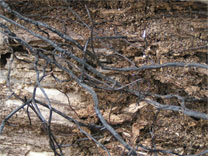
Rhizo-what!? Honey mushrooms infect trees and plants by sending out long, black cords are known as rhizomorphs (see picture at right). They twist and turn like tentacles.
You can usually find the rhizomorphs by looking at the surface of nearby trees or logs. Do note that the presence or absence of them does not guarantee correct identification. A spore print should still be taken!
Honey Fungus as Food
Yes, these mushrooms are edible. They have, as you can imagine, a slightly sweet taste along with a chewy, first texture.
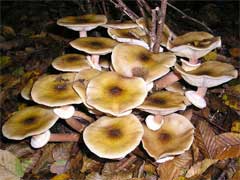
To parboil honey fungus, fill a pot with water and bring it to a boil. Toss in your mushrooms and let them cook for one minute, two tops. Then drain them and run cold water over them so they don’t cook further and become mushy.
Parboiling removes some of the stomach irritants and bitterness. After that they can be wiped off and sliced for cooking. The stems of these mushrooms can be quite tough, and some people prefer to discard them.
Honey mushrooms go well with pasta dishes, stuffings, and soups. Adding them to French onion soup will create a wonderfully earthy/sweet taste to the soup’s normal saltiness. They’re also good when sauteed on their own.
Be sure to cook these mushrooms well, as they may still cause you to get sick. Also, only eat a small amount if trying them for the first time.
As you can see, the honey fungus is comprised of some fascinating species!
If you need a good mushroom identification book, check out the National Audubon Society Field Guide to North American Mushrooms.

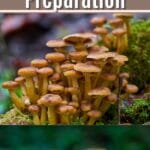
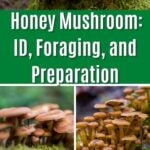
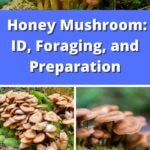
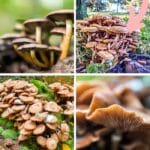
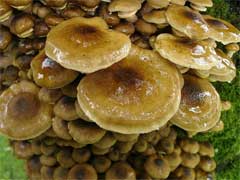 Most species produce medium-sized mushrooms found growing on wood. Their caps range from different shades of brown to yellowish in color.
Most species produce medium-sized mushrooms found growing on wood. Their caps range from different shades of brown to yellowish in color.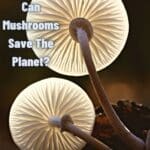
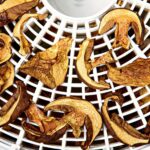
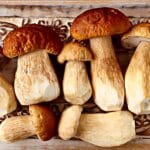
Leave a Reply